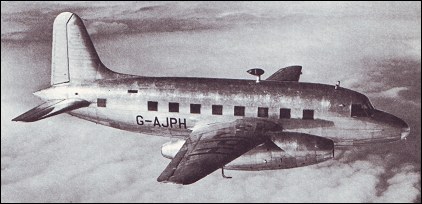 |
Vickers 618 Nene Viking1948 |  |
| AIRLINER | Virtual Aircraft Museum / United Kingdom / Vickers |
 |
While the first Nene-Lancastrian can be dubbed 'the world's first jet airliner' only in that in 1946 it took passengers for rides in an uncanny near-silence, and with a total lack of the vibration to which airline travellers were then used (with its surplus piston engines switched off). It could not really be called an airliner at all but only an engine testbed. The Nene-Viking was a different proposition. It has also been called 'the first jet airliner' but with much more justification. It was a true airliner, designed from the start as a civil transport and in its normal form, powered by piston engines. At an early stage in the programme the Ministry of Supply, then the government procurement agency for aircraft, decided to order one Viking with turbojets instead of the usual Hercules sleeve-valve radial piston engines. This was partly in order to assist general development of jet airliners, and see what problems might arise, and partly to furnish ministers and officials with a comfortable executive transport. The 107th airframe on the Weybridge production line was set aside, and the designers schemed a series of major changes. The existing nacelles were replaced by completely new jet pods each housing a Rolls-Royce Nene, with the trailing edge of the wing extended at the rear to fair smoothly into the top of the pod. The Vickers main landing gears were of a totally new type, designed only for this aircraft, with four separate short legs each carrying a wheel which retracted to lie on each side of the jet pipe inside the nacelle. Unlike other Vikings the elevators were skinned with metal, and the metal skin on the wings and tailplane was made thicker than normal. There were also changes to the cockpit, fuel system and other items. Chief test pilot J 'Mutt' Summers flew the Type 618 Nene-Viking from Wisley on April 6, 1948. At different times it bore civil registration G-AJPH and Ministry serial VX856. On the 39th anniversary of Bleriot's crossing of the Channel, on July 25, 1948, the Nene-Viking loaded with passengers (24 was the usual maximum) at London Heathrow and flew them in great comfort to Villacoublay, Paris, in 34 min 7 sec, less than half the regular scheduled time and faster than a previous record set by a Spitfire. Six years later it was sold to Eagle Aviation and rebuilt as an ordinary Viking IB freighter, with Hercules engines, and put into service as Lord Dundonald on September 24, 1954. Bill Gunston "The Illustrated Encyclopedia of Commercial Aircraft", 1980

Phil Johns, e-mail, 16.07.2023  Sqn Ldr George Shelley RAF(Ret Sqn Ldr George Shelley RAF(RetI was an apprentice at Eagle Aircraft Services at Blackbushe and flew in G-AJPH from Blackbushe to London Airport. This was after the conversion to a piston engine. The airfame was retired from service in the late 60s and broken up and put in a sand pit near Heathrow.
|  COMPANY PROFILE | ||||||||||||||||||||||||||||||||||||||||||||||||||||||
 |

|


Unfortunately it was converted back to a propeller Viking and used as a cargo transport.
Shame really with an extended fuselage, greater fuel capacity and tripod gear it could have been the basis for a viable production medium haul liner
reply